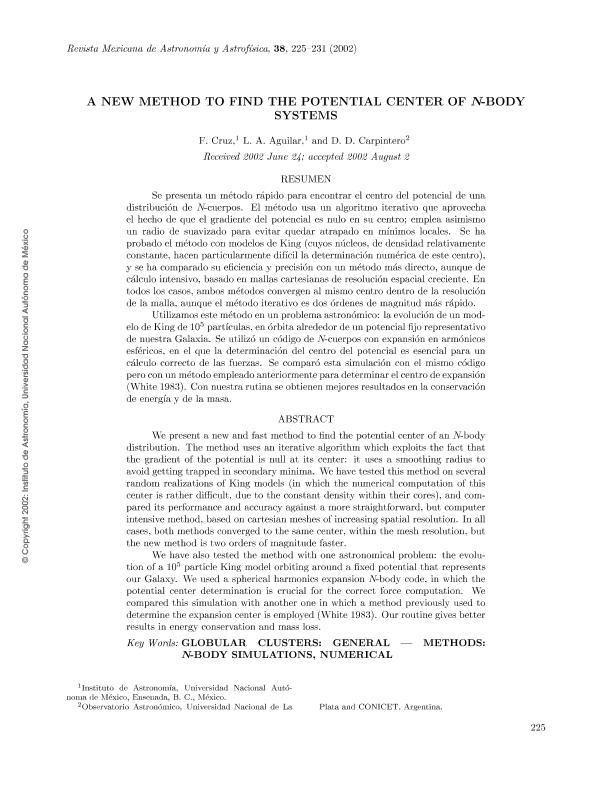Mostrar el registro sencillo del ítem
dc.contributor.author
Aguilar, L. A.

dc.contributor.author
Cruz, F.
dc.contributor.author
Carpintero, Daniel Diego

dc.date.available
2018-02-22T14:21:36Z
dc.date.issued
2002-09
dc.identifier.citation
Aguilar, L. A.; Cruz, F.; Carpintero, Daniel Diego; A new method to find the potential center of N-body systems; Universidad Nacional Autónoma de México. Instituto de Astronomía; Revista Mexicana de Astronomía y Astrofísica; 38; 9-2002; 225-231
dc.identifier.issn
0185-1101
dc.identifier.uri
http://hdl.handle.net/11336/36956
dc.description.abstract
We present a new and fast method to nd the potential center of an N-body
distribution. The method uses an iterative algorithm which exploits the fact that
the gradient of the potential is null at its center: it uses a smoothing radius to
avoid getting trapped in secondary minima. We have tested this method on several
random realizations of King models (in which the numerical computation of this
center is rather dicult, due to the constant density within their cores), and com-
pared its performance and accuracy against a more straightforward, but computer
intensive method, based on cartesian meshes of increasing spatial resolution. In all
cases, both methods converged to the same center, within the mesh resolution, but
the new method is two orders of magnitude faster.
We have also tested the method with one astronomical problem: the evolu-
tion of a 105 particle King model orbiting around a xed potential that represents
our Galaxy. We used a spherical harmonics expansion N-body code, in which the
potential center determination is crucial for the correct force computation. We
compared this simulation with another one in which a method previously used to
determine the expansion center is employed (White 1983). Our routine gives better
results in energy conservation and mass loss.
dc.format
application/pdf
dc.language.iso
eng
dc.publisher
Universidad Nacional Autónoma de México. Instituto de Astronomía

dc.rights
info:eu-repo/semantics/openAccess
dc.rights.uri
https://creativecommons.org/licenses/by-nc-sa/2.5/ar/
dc.subject
Globular Clusters
dc.subject
Numerical Methods
dc.subject
N Body Simulations
dc.title
A new method to find the potential center of N-body systems
dc.type
info:eu-repo/semantics/article
dc.type
info:ar-repo/semantics/artículo
dc.type
info:eu-repo/semantics/publishedVersion
dc.date.updated
2018-02-19T16:54:24Z
dc.journal.volume
38
dc.journal.pagination
225-231
dc.journal.pais
México

dc.journal.ciudad
México
dc.description.fil
Fil: Aguilar, L. A.. Universidad Nacional Autonoma de Mexico. Instituto de Astronomia; México
dc.description.fil
Fil: Cruz, F.. Universidad Nacional Autonoma de Mexico. Instituto de Astronomia; México
dc.description.fil
Fil: Carpintero, Daniel Diego. Universidad Nacional de la Plata. Facultad de Ciencias Astronómicas y Geofísicas; Argentina
dc.journal.title
Revista Mexicana de Astronomía y Astrofísica

dc.relation.alternativeid
info:eu-repo/semantics/altIdentifier/url/http://adsabs.harvard.edu/abs/2002RMxAA..38..225C
dc.relation.alternativeid
info:eu-repo/semantics/altIdentifier/url/http://www.astrosmo.unam.mx/rmaa/RMxAA..38-2/PDF/RMxAA..38-2_cruz.pdf
Archivos asociados
